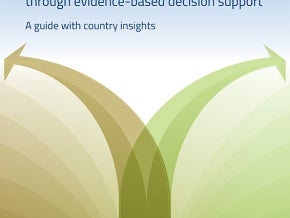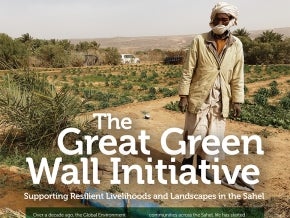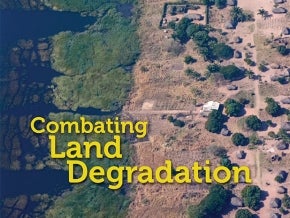Waste not, want not: How farmers are cutting down on chemicals with a natural solution to soil degradation

At age 56, Vietnamese farmer Luan is still actively working the land. She is also still learning new things and open to fresh ideas. In 2015, she agreed to turn part of her smallholding into a demonstration site as part of Biochar for Sustainable Soils – a three-year research and knowledge dissemination project backed by UN Environment and the Global Environment Facility and coordinated by Starfish Initiatives.
With assistance from researchers at Thai Nguyen University of Sciences, Luan learned to produce biochar, an organic soil enhancer, in her home and apply it to her crops. She is one of 100 farmers in Viet Nam’s Bac Kan province to be trained in its use as a natural alternative to chemical fertilizers.
Biochar is made from heating organic or agricultural ‘waste’, such as rice husks or straw, without the presence of oxygen. This produces a charcoal-like substance which is not only rich in carbon, but is highly porous, helping the soil to retain nutrients and water.

Biochar use among subsistence farmers is believed to be thousands of years old, yet research on its potential to enrich soil and mitigate the impact of increasingly severe land degradation on global food security is still in its infancy. While trials have so far mainly been confined to laboratories, the Biochar for Sustainable Soils project was carried out at field sites across six different countries, allowing opportunities for knowledge sharing on a global scale.
Here in Quang Chu commune, Luan’s smallholding is one of ten experimental sites set up to demonstrate and promote biochar use among local farmers.
Luan says she used to think that fertilizer was essential for a good harvest and spent a substantial amount of the household budget on purchasing chemical fertilizers.
“My parents always used it; so I used it too,” she explains. “But each year we had to apply more to achieve the same yield. We were spending around three million dong per year (US$130) just on fertilizer.”
Aside from the expense, the decline in soil quality on her plot gave her doubts about her method. “The soil became more compact and acidic,” she says. “It was hard to plough.”

Luan says she also noticed chemical residues floating in the village’s water source. Tests proved that the water contained abnormally high calcium levels.
While at first she was sceptical when the university offered her training on how to mix burnt rice husks with animal dung, the benefits soon became clear.
The Biochar for Sustainable Soils team provided her with a subsidised stove on which to make the natural fertilizer and divided the demonstration plot into two sections: the first relied on agrochemicals as usual, while the second received regular biochar boosts. As time passed, the colour and texture of the soil on the second plot became noticeably different. A 15 to 20 per cent increase in yield for her rice, maize, and cassava crops was enough to make Luan a staunch advocate of the new approach. She has now more than halved her fertilizer use, saving over US$75 a year – in addition to the income boost from her land’s increased productivity.
And she is not alone; farmers across the Biochar for Sustainable Soils project’s demonstration sites have shown an eagerness to adopt this organic alternative to conventional fertilizers.
With more than 500 farmers already trained in biochar use – from Ethiopia to Peru, Kenya, China, Indonesia, and Viet Nam – Biochar for Sustainable Soils technical committee Chair and Agriculture NSW Principal Research Scientist Annette Cowie says the project has shown the great potential of biochar as an effective soil amendment for sustainable land management.
“The project has shown that biochar made from locally available biomass residues can enhance plant growth and reduce fertilizer requirements, in a range of soil types, across six countries,” Cowie says.
With farmers across the six project countries keen to put biochar to use, the project team is now working on overcoming barriers to more widespread adoption, such asbiochar’s time-consuming production process. In Viet Nam, this means encouraging commercial production to upscale and mainstream biochar.

“Collaboration between scientists, commercial manufacturers, and farmers is needed to produce biochar at affordable prices,” Biochar for Sustainable Soils research team leader and Deputy Head of the Faculty of Earth Sciences and Environment at Thai Nguyen University of Sciences Mai Thi Lan Anh says. “Farmers are willing to buy it!”
“The project has demonstrated that nature-friendly solutions have multiple benefits for communities,” UN Environment Biodiversity and Land Degradation Portfolio Manager Johan Robinson says.
“From improving the productivity of soil to achieve higher yields, to helping manage waste and increasing carbon sequestration capacity – the advantages are clear. It’s now time to think about how to upscale the findings of the project to reach even more farmers globally.”
This story was originally published by UN Environment.
To learn more about the Biochar for Sustainable Soils project and UN Environment’s work in Land Degradation, contact Ersin Esen.


